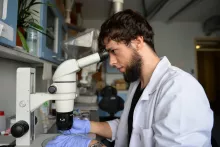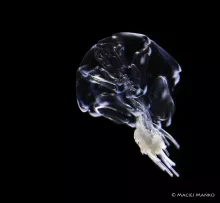EMBRC grant for Maciej Mańko
Mr. Maciej Mańko, a PhD Student at Division of Marine Plancton Research (Institute of Oceanogrphy) has received a grant funded by European Marine Biology Resource Centre (EMBRC). During the period of four weeks he will conduct research on Siphonophores at Observatoire Océanologique de Villefranche-sur-Mer (France).
Tittle of project: Calycophoran eudoxid – a highest level of zooids’ functional specialization?
Siphonophores are planktonic hydrozoans (Cnidaria), found in every zone of the oceans and characterized by unique morphologies and developmental modes. They can form lengthy colonies composed of functionally specialized zooids (individuals), arranged in clusters, called cormidia.The species-rich suborder Calycophora represents a particularly intriguing life cycle, where gamete production happens in a dispersive element, called eudoxid, derived from the colony; the posterior-most cormidium is actively separated from the colony, thus producing a free fragment which disperses away and later on will release gametes. Given that a calycophoran colony can produce dozens of eudoxids during its life span, this mode of dispersion has profound consequences over the overall population dynamics. Building on preliminary results that we obtained previously at the marine station of Villefranche-sur-mer, we have formulated the hypothesis that eudoxid release evolved by acquisition of a new function by a specialized zooid, the bract, which ancestrally has a role of shelter and protection for the colony. In calycophores, bracts seem to be responsible for the active separation of the eudoxid from the colony. To properly test this hypothesis, we propose a comparative study on seven chosen species, sampled from the bay of Villefranche. During this four weeks project, we will first test, by microdissections, whether bract-deprived specimens of each of the seven species are able to release eudoxids, and secondly analyze changes in bract morphology during eudoxid release using actin/tubulin fluorescent staining.








